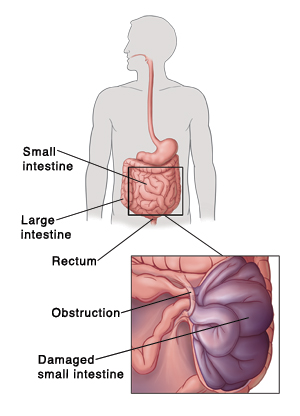A
B
C
D
E
F
G
H
I
J
K
L
M
N
O
P
Q
R
S
T
U
V
W
X
Y
Z
Click a letter to see a list of conditions beginning with that letter.
Click 'Topic Index' to return to the index for the current topic.
Click 'Library Index' to return to the listing of all topics.
Small Bowel Obstruction
A small bowel obstruction occurs when part or all of the small intestine (bowel) is blocked. As a result, digestive contents can’t move through the bowel and out of the body correctly. Treatment is needed right away to remove the blockage. This can ease painful symptoms. It can also prevent serious problems, such as tissue death or bursting (rupture) of the small bowel. Without treatment, a small bowel obstruction can be fatal.
 |
| Small bowel obstruction can lead to tissue damage and even tissue death. |
Causes of small bowel obstruction
A small bowel obstruction can be caused by:
-
Scar tissue (adhesions). These may form after belly (abdominal) surgery or an infection.
-
Hernia. A hernia is when an organ pushes through a weak spot or tear in the abdomen wall. Part of the small bowel can push out and be seen as a bulge under the belly. Hernias can also occur internally.
-
Certain health problems. These include when part of the bowel slides inside another part (intussusception). Other causes include irritable bowel disease such as Crohn’s disease, and inflammation and sores in the intestine (ulcerative colitis).
-
Abnormal tissue growths (tumors). These can form on the inside or outside of the small bowel. They are usually due to cancer.
Symptoms of small bowel obstruction
Common symptoms include:
-
Belly cramping and pain
-
Belly swelling and bloating
-
Upset stomach (nausea) and vomiting
-
Can't pass gas
-
Can't pass stool (constipation)
-
Diarrhea
Diagnosing small bowel obstruction
Your provider will ask about your symptoms and health history. You’ll also have a physical exam. Tests may also be done to confirm the problem. These can include:
-
Imaging tests. These provide pictures of the small bowel. Common tests include X-rays and a CT scan.
-
Blood tests. These check for infection and other problems, such as excess fluid loss (dehydration).
-
Upper GI (gastrointestinal) series with a small bowel follow-through. This test takes X-rays of the upper digestive tract from the mouth through the small bowel. An X-ray dye (contrast fluid) is used. The dye coats the inside of your upper digestive tract so it will show up clearly on X-rays.
Treating small bowel obstruction
Treatment takes place in a hospital. As part of your care, the following may be done:
-
No food or drink is given by mouth. This allows your bowels to rest.
-
An IV (intravenous) line is placed in a vein in your arm or hand. The IV line is used to give fluids and medicines. These may be needed to ease pain, nausea, and other symptoms. They may also be needed to treat or prevent infections.
-
A soft, thin, flexible tube (nasogastric tube) is inserted through your nose and into your stomach. The tube is used to remove extra gas and fluid in your stomach so that the bowels can rest. This helps ease symptoms such as pain and swelling.
-
In some cases, surgery is done. This may be needed if the small bowel is almost or totally blocked, if symptoms continue even after treatment, or if there is a hole in the bowel (bowel perforation). During surgery, the blockage is removed. Parts of the bowel may also be removed if there is tissue death. Other repair may be done as well, depending on what caused the blockage. Your healthcare provider will give you more information about surgery, if needed.
-
You’ll be watched closely in the hospital until your symptoms improve. Your provider will tell you when you can go home.
Long-term concerns
After treatment, most people recover with no lasting effects. If a long part of the bowel is removed, there is a greater chance for lifelong digestive problems. Bowel movements may become irregular. Work with your provider to learn the best ways to manage any symptoms you may have, and to protect your health.
When to call your healthcare provider
Call your provider right away or seek immediate medical care if you have any of the following:
Online Medical Reviewer:
Jen Lehrer MD
Online Medical Reviewer:
L Renee Watson MSN RN
Online Medical Reviewer:
Rita Sather RN
Date Last Reviewed:
3/1/2022
© 2000-2024 The StayWell Company, LLC. All rights reserved. This information is not intended as a substitute for professional medical care. Always follow your healthcare professional's instructions.